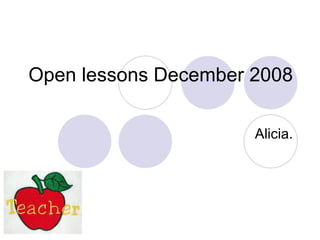Open Lessons December 2008
- 1. Open lessons December 2008 Alicia.
- 2. Language Zipper ©C a noun. Zip ©C a verb. Zip up your jacket, itĪ»s getting cold. No: Fasten with a zipper. Lip ©C a noun and a verb My lips are soft, my lips are red. Lipstick ©C a noun and a verb, makeup that is used to color the lips.
- 3. Language Medicine ©C a drug Medication - the act or process of treating with medicine. Chinese medicine. Western medicine. Coffee - strong - dark - cappuccino She was sipping her coffee.
- 4. Language FrogĪ»s life. 1. Spawn ©C the mass of eggs. 2. Egg. 3. Tadpole. 4. Froglet. 5. Frog.
- 5. Language Handbag / Purse Shopping bag Backpack Belt bag Tea bag Plastic bag
- 6. Correct the mistake You shouldnĪ»t touch the fish. Dommie come to our class. The frog says, Ī░Quack.Ī▒ Tell to the Sunny. Point to the letter Ī░Up.Ī▒ What is behind the letter V? Please, donĪ»t touch the fish. Dommie is coming to our class. The frog says, Ī░Croak.Ī▒ Tell it Sunny, please. Point to the word Ī░Up.Ī▒ What is after the letter V?
- 7. Correct the mistake Point to window. Look at whiteboard. Daddy isnĪ»t here. Look at here! A tadpole become a frog. Very thank you! Point to the window. Look at the whiteboard. Daddy is not here. Look here! A tadpole becomes a frog. Thank you very much!
- 8. Correct the mistake ItĪ»s house. Tina want you to hear the story. I have a friend who live in a fish tank. A fish live in a pond. Put the tadpole? Where? No water in my marker. ItĪ»s a house. I want you to listen to the story. I have a friend who lives in a fish tank. A fish lives in a pond. Where is the tadpole? My marker is dry! There is no ink in my marker.
- 9. Read this together. Later Break
- 10. Cow Fasten
- 11. Show Window
- 12. Spawn Web World Wide Web
- 13. Crayon Wake up
- 14. Where Vest
- 15. Up Slowly
- 16. Next Look
- 17. Bird Quack
- 18. Snack Whisper
- 19. Baby class teachingĪŁ Take care of your kids first: - kids are clean; - kids are not hungry; - kids are not thirsty; - kids donĪ»t want to go pee-pee; - kids are not tired; - kids are felling good (not cold or hot); - kids are happy.
- 20. Baby class teachingĪŁ Establish the classroom rules: 1. 2. 3. 4. 5. 6. 7. 8.
- 21. Baby class teachingĪŁ Use the Visual Aid efficiently: 1. 2. 3. 4. 5. 6. 7. 8.
- 22. Positive teaching tips. Preparation: Prepare an excellent lesson; Find a lot of interesting games, songs, activities and craft ideas for every day; Teach you lessons in different locations; Know the level of your kids development, to adapt your teaching techniques; Use role-plays for your lesson and set the mini theatre in the classroom.
- 23. Positive teaching tips. ItĪ»s time for class! Be ready! Smile! Be a good role model! More praise! Use TPR to teach. No shouting!!!!!!
- 24. 1. 2. 3. 4. 5. 6. 7. 8.
- 25. Baby class teachingĪŁ Lessons are very important!!! Use all the help you need! Teachers! Nannies! Parents! Thank you! See you later!

























